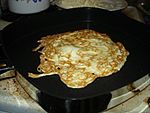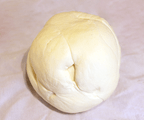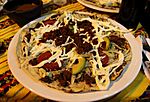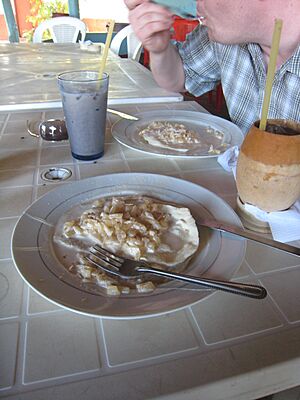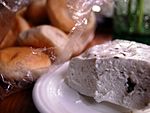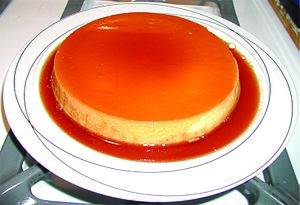Quesillo facts for kids
Quesillo (pronounced keh-SEE-yoh) means "little cheese" in Spanish. It's a popular name for many different foods and dishes across Latin America, Spain, and the Philippines. What it means depends on where you are in the world!
Contents
Quesillo in Argentina
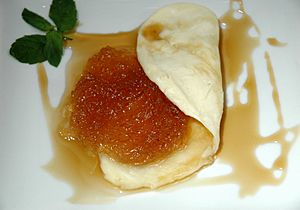
In Argentina, quesillo is a special cheese from the Calchaquíes and Lerma valleys. It has a long history, going back to when Spanish and local recipes mixed together.
This cheese is made by hand. It uses milk from cows or goats. The cheese is stretched and spun in a special way. This gives it its unique texture and taste.
Quesillo in Chile and Bolivia
In Chile and Bolivia, quesillo is a small, fresh cheese. It is a popular farm cheese in the Cochabamba valley.
This cheese is usually made from fresh cow's milk. It uses a process that makes small curds. After resting for a few hours, it becomes crumbly and ready to eat.
Quesillo in the Canary Islands (Spain)
In the Canary Islands of Spain, quesillo is a dessert. It is a type of flan. This dessert is made with whole eggs and sweetened condensed milk.
This makes it firmer than a regular flan. The Spanish quesillo is similar to the Venezuelan quesillo, which is also a dessert.
Quesillo in Colombia
In Colombia, quesillo is a type of double cream cheese. It is wrapped inside a plantain leaf. This cheese first came from the Tolima Department. The town of Guamo is very famous for it.
Today, it is also made in other dairy areas. These include Bogotá, Ubaté, and parts of Cundinamarca and Antioquia. Some well-known brands are Pasco and Colanta.
Quesillo in the Dominican Republic
In the Dominican Republic, quesillo is a dessert. Recipes can be a little different, but it is usually a flan. It is made with eggs and sweetened milk.
Quesillo in Mexico
In Mexico, quesillo is a very popular type of string cheese. It is sold in balls of different sizes. People also call it "Queso Oaxaca" or Oaxacan cheese.
-
A tlayuda topped with quesillo
Quesillo in Nicaragua
In Nicaragua, quesillo is a special dish. It has a thick corn tortilla wrapped around soft cheese. This cheese is similar to mozzarella. The dish also includes pickled onions and a sauce. The sauce is usually sour cream or liquid cheese with vinegar.
This dish comes from the León Department. There is a friendly debate about where it was first made. Some say it was in Nagarote, others say La Paz Centro. The main difference is that quesillos from La Paz Centro use purple onions.
Quesillos are often sold by the side of the road. Women called quesilleras sell them as a quick snack. The most famous quesillo stands are on the highway between León and Managua.
Because they can be messy, quesillos are often served in a thin plastic bag. People usually bite off a small corner of the bag. Then they squeeze the quesillo out through the hole.
Quesillo in Peru
In Peru, quesillo means small pieces of fresh cheese. This cheese is often made by families at home. Women sell it on streets, in markets, and in small shops.
This type of cheese is very common in the Andean mountains. People use it in stews and soups.
Quesillo in the Philippines
In the Philippines, quesillo refers to different soft, white cheeses. These cheeses are not aged. They are made from milk from a carabao (water buffalo) or goat. The milk is curdled with vinegar, citrus juices, or sometimes rennet.
The name changes a bit depending on the region. In the island of Luzon, it is called kesong puti in Tagalog. In Caviteño, it is kesilyo or kasilyo. In Cebu, a similar cheese is known as queseo or kiseyo.
-
Tagalog kesong puti or kesilyo
-
Cebuano queseo
Quesillo in Venezuela
In Venezuela, quesillo is a type of dessert. It is made with eggs, condensed milk, and caramelized sugar. The Venezuelan quesillo is similar to the French-Spanish dessert called crème caramel or flan.
The original recipe from the 1700s did not use condensed milk. Instead, it used regular milk and sugar. This sweet, jelly-like dessert has a unique taste.
This dessert is also popular on the Dutch Caribbean islands. These include Aruba, Bonaire, and Curaçao. These islands are located just off the north coast of Venezuela. In the Philippines, a similar dish is known as leche flan.
See also
 In Spanish: Quesillo para niños
In Spanish: Quesillo para niños


